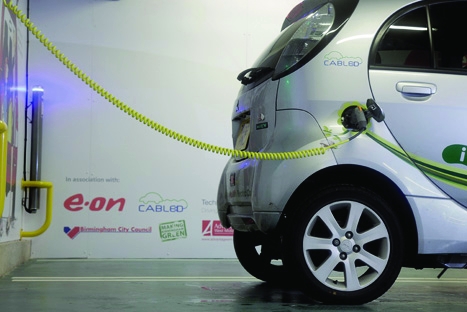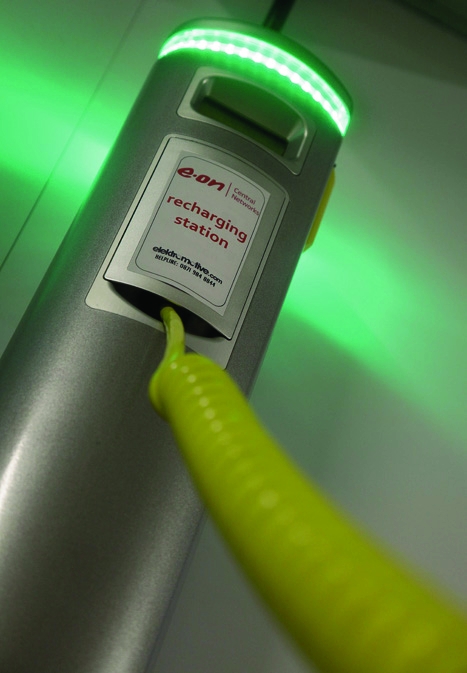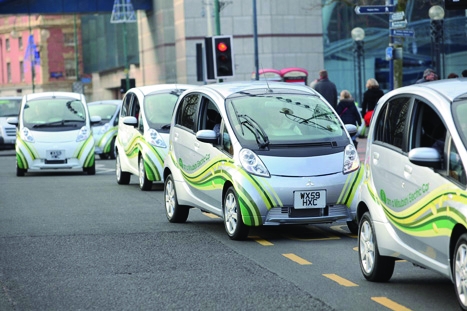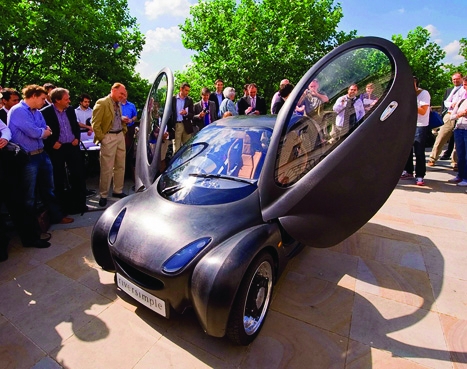
You get in your car and turn the ignition. The fuel gauge creeps up; you check it, calculate in your head how far you’ve got to drive and think about whether you’ve got enough petrol. If not, you know roughly how far you’ll get and whether to fill up beforehand.
It’s easy enough; cars are ingrained into our culture and, more importantly, into our infrastructure. Petrol stations are plentiful and fuel consumption is easily understood. It’s actually pretty difficult to run out of petrol. But as more electric cars come onto our roads, the picture could change in many ways. Is a full charge equivalent to a full tank of petrol? Where and how will you charge your car? What kind of infrastructure will we need to make sure that people will be able to charge their cars when they need to? And how will you pay for the electricity?
It’s a complicated subject that will affect a range of industries and sectors, many of which have not been involved with each other before. Electricity suppliers, for example, haven’t had to be overly concerned with the business of automotive manufacturers. Power generation hasn’t had to be linked to the way people drive. But all of that is going to have to change. And soon.
Many automotive manufacturers see electric cars as a major market opportunity and they want to grab it
Prof Roger Kemp, Lancaster University
’This all comes down to the Climate Change Act 2008,’ said Prof Roger Kemp of Lancaster University, one of the authors of a recent report from the Royal Academy of Engineering (RAEng) on the issues connected with electric cars (read more on this here). ’When the discussion of the act first started, it talked about a 60 per cent cut in CO2 emissions by 2050; but roughly a month before it became law, that was changed to an 80 per cent cut. At the time, I don’t think anyone in the engineering profession realised what a dramatic change that was going to be.’

The numbers are important here because fully a quarter of the UK’s carbon emissions come from road vehicles. ’If you have to make an 80 per cent reduction, then you absolutely have to do something about road vehicles,’ Kemp added. ’Either you have to make a draconian cut in the amount of energy used in road vehicles, or you end up with electric vehicles.’
If you think about electric vehicles as a way to meet those obligations, then you have to think big. ’We aren’t talking about tens of thousands of electric cars, or even hundreds of thousands,’ Kemp said. ’There are something like 30 million cars on the roads of Britain at the moment. So, if 10, 15 or 20 million of those become electric cars, what are the implications of that; and particularly for us, what are the implications for engineers and engineering?’
The automotive sector isn’t dragging its feet. ’We have been really struck by the readiness of motor manufacturers to meet the challenge of electric vehicles,’ Kemp said. ’Many companies see this as a major market opportunity and they want to grab it; Nissan’s Leaf electric family car, which will be built in the UK, is a great example.’
We aren’t talking about tens of thousands of electric cars here, or even hundreds of thousands. There are 30million cars on Britain’s roads at the moment.
Prof Roger Kemp, Lancaster University
The development of electric vehicle technology itself is an issue, according to Kemp, particularly when it comes to batteries. Lithium-ion seems to be the most likely system, but these batteries, which Kemp described as scaled-up laptop batteries, are not cheap. A car would probably need a battery weighing 50-100kg; at current prices, that would cost more than a medium-sized car. ’We have to bring down the price to something that makes the overall offering attractive to consumers,’ he added.
But it’s the wider issue of infrastructure that could be the bigger challenge. The targets of the Climate Change Act are the mid-term driver, but the new government has piled on the pressure. The Tory-Liberal coalition policy document issued following the election contained a commitment to construct a charging infrastructure for electric vehicles within the life of this parliament – the next five years. Once started, an infrastructure will have its own momentum; it will evolve over time, but the way it is first established will dictate its shape and the way it develops. So how do we make sure we get it right?
We want people to see that electric vehicles are just cars, like any other car. Public acceptance of them as normal is very important
Neil Butcher, ARUP
One good way is to see how people use electric cars and use that information to inform the establishment of an infrastructure. Last year, the Technology Strategy Board set up eight consortia to conduct ’demonstrator trials’ of electric vehicles, the largest of which, based in the West Midlands, recently issued its first report (see panel above). The CABLED (Coventry and Birmingham Low Emission Vehicle Demonstrators) consortium, led by Arup and involving E.On along with Aston, Birmingham and Coventry universities, will study a fleet of 110 vehicles, of which the first 25 – Mitsubishi iMiEVs – are already in the field. The rest of the fleet, consisting of 40 Smart FourTwo EVs, 25 Tata Indica Vistas, five Land Rover range extenders, five LTI black taxis, and 10 micro:cab urban hydrogen fuel-cell cars, will roll onto the streets in the coming months.

’Part of the idea is just to make electric vehicles a more common sight on the roads,’ said Neil Butcher, project co-ordinator at Arup. ’We want people to see that they’re just cars, like any other car, and they mix with ordinary traffic and aren’t any sort of hazard. Public acceptance of them as something normal is actually a very important part of their take-up.’ Butcher is doing his bit in this: he’s one of the iMiEV drivers, as are television presenters Robert Llewellyn and Quentin Wilson.
But the main role of the project is to see how drivers use their cars. Each driver has a charging point set up at their home, capable of charging the car to 85 per cent capacity in 20 minutes; some also have one at their workplace, or will use public charging points. The cars will charge to full capacity from a standard power socket in eight hours. ’We want to log how far a typical journey is; how often people recharge and where they do it; how fast they go; what sort of traffic they travel in; all that sort of thing,’ Butcher said. ’That will give us the information we need to decide how to set up charging infrastructure.’
Among the issues is how much power would need to be routed to particular locations at particular times. For example, one obvious place to site charging points is a car park. But depending on how people charge their cars, this could create problems. ’Let’s imagine the car park at Old Trafford football ground,’ said Kemp. ’You could have 5,000 people driving there for an evening game; they get to the ground around 6pm and plug their cars in. Then they expect them to be fully charged about three hours later when they leave.’ That, he said, is a huge amount of power at a time where there currently isn’t much demand and, at the moment, the distribution system isn’t set up to cope. ’It’s a massive challenge to the distribution network and it would be difficult to fund economically, because it’s only going to be used once or twice a week for certain parts of the year.’
Butcher believes that the answer might be in different types of charging point. He said: ’We’re involved in developing fast-charging points, such as the ones installed at our drivers’ homes. The idea is that they would be installed at motorway services and suchlike, and they would charge the car in half an hour or so.’
The infrastructure would still have to be set up to cope with demand, however. This, Butcher suggested, would be an ideal application of smart grid technology. ’More than 90 per cent of all cars are parked at any one time,’ he said. ’The smart grid idea is that your car is always plugged in when it’s parked and the battery acts as a reservoir to supply power during the day. At night, when the electricity is cheap, the battery charges up.’
Any electric vehicle is only as green as the electricity that charges it. If we’re serious abotu this, greening the electricity supply has to be the biggest prerequisite.
Prof Roger Kemp, Lancaster University
Such a system could benefit from the use of inductive charging, where rather than being plugged in, the car charges via a wireless link between a pad in the chassis and a charging station buried in the road or drive underneath the car. This could help with the problem of how to charge your car if you don’t have off-street parking and would mean that drivers would, essentially, never have to worry about charging; simply parking in the right place would take care of it, with all other systems automatic. Payment would be via a meter in the car, Butcher said; this would monitor flows of current into and out of the car battery. This type of system is already being used in cities in Japan and Italy, notably with bus fleets, said Dick Stimpson of Arup, who is working on inductive charging projects. ’They require virtually no maintenance; the buses have a guaranteed parking place with a charging pad, and they are always charged.’ Butcher added that car companies are looking favourably on inductive technologies, seeing it as a premium option and the most likely route for future electric vehicle charging. ’There might be the scenario where you buy a high-end electric car that comes with supply and installation of an inductive charging pad at your property,’ he said.
Then there’s the matter of standardisation. Prof Phil Blythe of Newcastle University, another author of the RAEng report, points out that although it will be local authorities that are responsible for installing the charging points, they will have to conform to the same standards of voltage, AC or DC and, if AC, the same frequency and so on. He said: ’This is a real challenge – to make sure that you can travel anywhere in the UK and be confident that you’ll be able to plug into a charging point and that it will work.’
This isn’t just a matter of UK standards, Butcher noted; the whole of Europe is likely to switch on to electric cars, and with cross-border travel the norm on the continent, there will have to be a standard so that, for example, a car can plug in in Frankfurt, Strasbourg and Brussels and still charge. Will there have to be a special standard for the UK? ’Car makers will have to talk to the distributors and the manufacturers of the charging points,’ Butcher said.
The road to electric cars is clearly a long one, and as beset with possible obstructions as the M25 at rush hour. The journey needs a series of good navigators and a decent map. Kemp, however, made a crucial point. ’Any electric vehicle is only as green as the electricity that charges it. There is little likelihood of making big savings in CO2 if we continue to burn coal or gas. If we’re serious about this, greening the electricity supply has to be the biggest prerequisite.’
The data
Drive time
The first report from the CABLED consortium
Distance: Average 23 miles/day, well within iMiEV’s 80-mile range; majority of journeys less than five miles. At these distances, conventional catalytic converters are at their least effective.
Energy use: Vehicles are parked for 97 per cent of the time, typically overnight and during school hours. They were left plugged in for 20 per cent of the time, occasionally for several days.
Drivers’ behaviour: The full speed range of the car was used, including motorway cruising speed. Vehicles were driven in all temperatures throughout the winter, down to a minimum of -10°C.
Alternative technology
Power play
Hydrogen-powered electric vehicles are bringing the potential of fuel cells back into the spotlight
Hydrogen hopes

While plug-in hybrid and range-extended cars have commanded the majority of attention over the past year or so, another type of electric vehicle, powered by hydrogen fuel cells, has slipped from view. Once believed to be the most likely form of electric vehicle, difficulties over hydrogen storage, safety and, once again, supply infrastructure have seen them slip down the agenda, at least in the UK.
However, research continues into fuel cells and their use to power vehicles. The Riversimple city car project, a trial of which was recently announced in Leicester, depends on hydrogen fuelling and another project based at Coventry University, the Low-Carbon Vehicle Technology Project, is evaluating their use for small- to medium-range travel.
’The biggest issue with hydrogen power is the cost of the fuel cell,’ said project director Mike Dickison. ’But if everyone said that it’s too expensive, we wouldn’t get any learning. So we’re currently accepting that the vehicles have a very high cost, but we’re using lightweight technology to keep the mass of the vehicle very low, using very good aerodynamics – in other words, getting the best out of the conventional technologies and combining that with a fuel cell.’
Dickison believes that fuel cells still have inherently more potential than hybrids. ’You’re paying for and packaging a generator, an engine, a whole lot of batteries and a motor set. There must be redundancy there. But we’re looking long term; we’re not saying that in three years’ time everyone’s going to be driving fuel cell vehicles.’




Nanogenerator consumes CO2 to generate electricity
Whoopee, they've solved how to keep a light on but not a lot else.